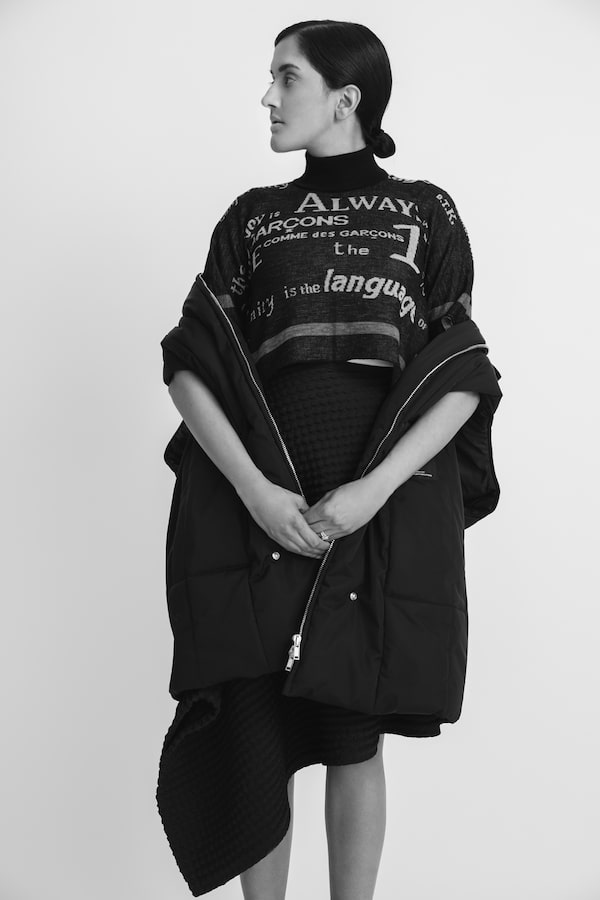What would a garment look like if you applied a specific mathematical formula to its dimensions? It’s a question often answered in the work of Sid Neigum, one of Anjli Patel’s favourite fashion designers.
Patel, a Toronto-based lawyer, has built a wardrobe of high-concept pieces. Unlike traditional tailoring, which was meant to flatter whatever silhouette was in fashion at any given moment, conceptual fashion looks to other disciplines or theories to determine designs. From the gender neutral creations of Rad Hourani to Vejas’s designs, where no seam is meant to be hidden, these garments are meant to provoke thought and challenge traditional ideas of attractiveness. “Fashion designers are artists: they use textiles as their medium and the human body as a canvas,” explains Patel, whose quirky ensembles always get her noticed at events. “I realized that fashion designers aren’t any different from artists in how they develop a body of work, and yet they don’t get anywhere near the degree of respect that artists get.”

Anjli Patel wears a Comme des Garçons sweater with a Sid Neigum skirt and a Raf Simons oversized vest that has a Robert Mapplethorpe photo on the back.Renata Kevah
Today, an increase in mindfulness among consumers is encouraging us to seek out deeper meaning in our attire, while the recent resurgence of feminism, notes Francesca Granata, assistant professor of fashion studies at Parsons School of Design, might mean that there’s more public interest in "less overtly sexualized silhouettes” – in other words, fewer women dressing for the male gaze.
Fashion designers have flirted with high-concept clothing ever since Elsa Schiaparelli unveiled her Skeleton Dress in 1938. The floor-length black gown seemed conventional from afar, but up close, it was possible to see the bas relief of a human skeleton on its surface. Using the trapunto quilting technique to mimic bones, Schiaparelli played with the idea of clothing as a second skin. Many of her contemporaries considered the dress to be in poor taste. By the time Rei Kawakubo, Yohji Yamamoto, Issey Miyake and Martin Margiela arrived on the scene in the 1980s, however, fashion was ready to look past the aesthetic norms of pretty and commercial ready-to-wear.
“I think of conceptual fashion – I use the word ‘experimental’ – as the kind of fashion that’s self-conscious sometimes, with experiments with either patternmaking, textiles or the way it’s presented,” Granata explains. “Conceptual fashion has a different relationship to the female body. It’s not as body hugging; it’s not as revealing. It’s less about the traditional idea of beauty.”
The idea of shunning the male gaze is what attracts many female fashion enthusiasts to conceptual fashion. For myself, after spending most of my twenties in fairly conventional garb, I came across an item that changed my outlook on fashion. I still remember holding up a pair of Issey Miyake pleated trousers, wondering if I could pull off such a curious shape. They were equal parts pants and equal parts sculpture. When I put them on, the fabric swayed around my legs like it had a mind of its own. They were far from flattering in the traditional sense, but all of sudden it didn’t matter: the pants were some kind of mathematical poetry in motion. It was freeing not having to subscribe to the rules of gendered silhouettes.
“I was always thinking, okay, now I am ready for the pencil skirt and the silk shirt and the pumps, but I have never really been ready for that,” says Samara Walbohm, co-owner of Type Books and co-founder of Scrapmetal Gallery in Toronto. Instead, Walbohm has established a wardrobe of “glorified pyjamas,” oversized pieces by Haider Ackermann and Celine, paired with designer sneakers and Birkenstocks. She hasn’t bought a pair of heels in more than a decade.

Samara Walbohm wears a Smythe Boy shirt and slouch pant, a vintage Japanese kimono from Latre, a vintage Pucci belt and Gucci footwear at the opening of Art Toronto. She is photographed in front of the work Big Pink Broken Green by Landon Mackenzie.George Pimentel
Similare to Patel, Walbohm tends to invest in Canadian designers with intellectual angles. She is partial to garments from the label Horses, founded by writers-slash-designers Heidi Sopinka and Claudia Dey. “They have an aesthetic that is so rooted and grounded in a philosophy of spirit, joy, freedom and beauty that is very singular to their vision,” Walbohm explains. ”When Jeremy Laing was working in fashion, I considered him more of an artist than a fashion designer, I loved most everything that he did. Especially his collaborations with artists like Julia Dault or Scott Treleaven.”
While Walbohm considers herself an impulse shopper, Patel’s buying habits can be distilled down to a science. “Concept, ethics and designer provenance are my top criteria, along with wearability, durability, practicality, sustainability and affordability,” Patel says. Even when purchasing a simple T-shirt, she turns to Canadian brand Kotn, whose fabrics and garments are ethically sourced and manufactured in Egypt. “Conceptual fashion is also imbued with meaning, which creates sentimentality and attachment, so the garment should have a longer life cycle. If I can better articulate why I like something, I’m less likely to get rid of it in the short term. So it boils down to sustainability.”
With the rise of labels such as Vetements, Y-Project and Off-White, conceptual fashion is slowly becoming a part of the daily fashion conversation.
It’s a sign, Granata says, of women’s shifting values. “By wearing these types of fashions, you are presenting yourself as somebody who is intellectual,” Granta says. “As someone who uses fashion in a more interesting way.”
Visit tgam.ca/newsletters to sign up for the weekly Style newsletter, your guide to fashion, design, entertaining, shopping and living well. And follow us on Instagram @globestyle.